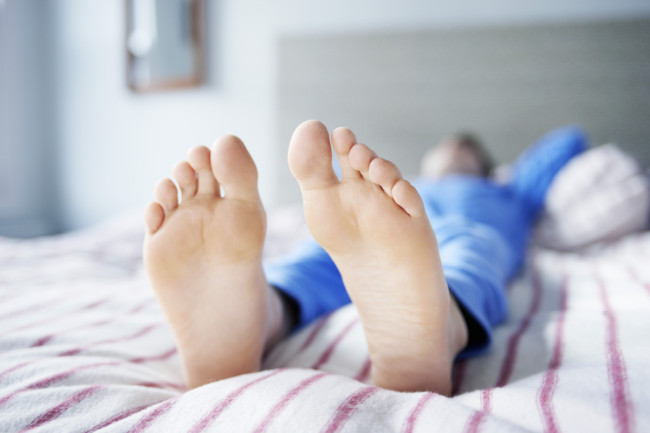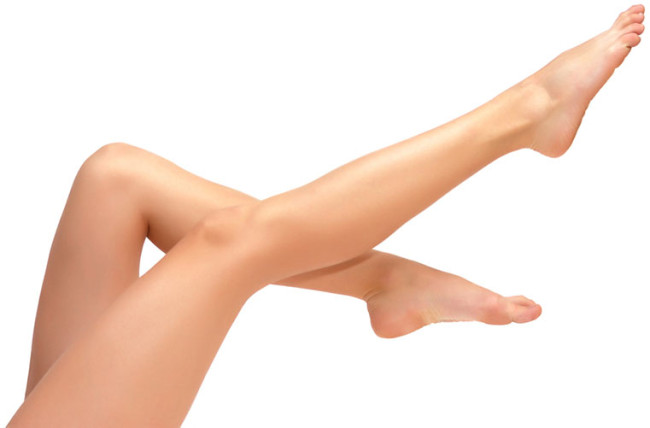Willis's disease or the disease “among the people” has a rather eloquent name - restless legs syndrome (SBN). This is a state when unpleasant sensations appear in the upper and lower extremities at night - they make you move and, of course, deprive you of sleep. It is worth noting that the movement that you make, paradoxically, cause relief. This picture is characteristic of a neurological disease. Willis's disease is suffered by adults, most often those who are at least 60 years old. But, like many other diseases, SBN has recently noticeably younger. It would seem what pleasure after a long work day come home and relax well. Agree that sometimes this is exactly what is necessary for happiness. What is the surprise of those who discover: after spending all day in running around ... The legs are not ready to rest! Contrary to fatigue and aching pain in the muscles, it seemed to climb under the skin: no matter how much the limbs are, they all itch. A familiar situation? A typical picture for restless legs syndrome.
Content
Restless legs syndrome: reasons
The syndrome of restless legs is primary and secondary.
In the event that SBN arose on its own - just like that, for no reason, from scratch, then doctors call this idiopathic or primary restless legs syndrome. According to experts, this disease is hereditary and is found mainly among relatives. This type of SBN is a rare occurrence. Most often, it is the secondary form of Willis's disease that is a consequence of some kind of ailment or a new state of the body. The problem is that this phenomenon is based on violations of the central nervous system, which manifest in the form of improper exchange of iron and dopamine.
Often such “misunderstandings” in the body happen to the following reasons:
- injury (especially if the brain is back);
- pregnancy;
- kidney disease (especially with renal failure);
- diabetes mellitus;
- anemia;
- alcohol poisoning (pronounced intoxication);
- overdose of drugs;
- side phenomenon after some medicines.
Restless legs syndrome: drugs that cause the disease
Some medications provoke restless legs syndrome, but doctors do not warn patients about this. We offer to get acquainted with the list of such “dangerous” medicines. If you have a hereditary predisposition to Willis's disease, you definitely need to know this!
List:
- all caffein -containing drugs;
- anti -excavation drugs that contain metoclopramide and coolroperazine;
- medicines for allergies (almost everything);
- antipsychotics;
- medicines for temperature that contain dipheningidine;
- antidepressants (tricyclic and SIOOS);
- all drugs containing lithium;
- drugs that reduce blood pressure;
- phenotiazins;
- antipsychotics (basis - risperidone or olanzapin);
- medicines for seizures (especially phenytoin, zonizamide and metesuximide).
Do not forget that alcohol is also very harmful, as it provokes the syndrome of restless legs: first it relaxes the muscles, and then leads to their contraction.
Restless legs syndrome: symptoms
- Unpleasant and “strange” sensations in the legs. Patients describe their condition in different ways: trembling, “goosebumps”, burning, “stirring”, “crawling”, twitching. At the same time, about 30% of patients claim that during the “attack” they experience pain. Most often, people simply cannot describe their condition for sure - it is quite difficult to characterize it, and therefore patients say: "It is so unpleasant at the feet." It is noteworthy, the area of \u200b\u200blocalization of “strange” sensations is diverse - it only stabbed in the thigh, immediately “goosebumps ran” in the foot, and then the movement was activated in the lower leg. At the same time, they roll like waves with a frequency of 5 to 30 seconds. As for the time of the day, basically attacks are overcome at night, but sometimes they may not stop even during the day. Restless legs syndrome often occurs during pregnancy, but after childbirth this phenomenon passes.
- The legs alone - the symptoms are stronger. Characteristic for SBN is the fact that at rest “goosebumps”, trembling and “crawling” become more noticeable. Especially all these sensory and motor symptoms are activated during the fall in the period. In order for the attack to begin, a different amount of rest time is needed - it is enough for one patient to sit down for 5 minutes, and the second needs to “wait” an hour or more.
- Legs in motion - symptoms disappear. The more move, the more likely the fact that the SBN will weaken or completely subside. Normal walking helps best, but a small physical activity can be a salvation: inclinations, jumps, exercises on simulators. It all depends on the patient and purely individual. Unfortunately, often movements give a slight respite, and then the symptoms with renewed vigor roll on a person. If the case is very severe, then the pain can only be eliminated for a short period of time.
- The circus nature of the symptoms. Early in the morning and in the first half of the day, the SBN almost never worries the patient. The situation is aggravated from about 17:00 to 05:00. Most often with dawn, even the most severe pains subside, giving the patient a small respite.
- Limb movements during sleep. Often during sleep, short legs occur with an interval of 40, or even in 5 seconds. About 70 to 90 % of people who were diagnosed with Willis's disease suffer from these symptoms. It is noteworthy, those who have a mild form have involuntary movements from about 60 to 120 minutes after a person fell asleep. But if the disease proceeds in severe form, then the movements of the legs can last all night.
- Insomnia. Very often, SBN is accompanied by insomnia, since it is sometimes difficult to fall asleep with such a problem, and if it is possible to “snatch” a couple of hours of sleep, then frequent awakening are guaranteed. Often insomnia goes into a chronic stage, so patients all the time want to sleep.
Restless legs syndrome: treatment
The treatment of this ailment depends on whether the primary or secondary form of the disease. The syndrome of restless legs is difficult to treat, everything is aimed at weakening attacks and their complete elimination. Therefore, a prosperous outcome depends on what degree and severity of the disease.
First of all, do not forget that SBN is a scarce state of the body, therefore it is necessary to fill in the lack of iron. (Moreover, SBN often occurs against the background of anemia).
As a treatment, iron sulfate is prescribed. It is worth noting that it must be taken for several months to see the first result and positive dynamics. At the same time, do not forget about folic acid, which can also provoke SBN.
Treatment with drugs is more effective, but it is necessary to follow certain conditions:
- Doses of drugs should be minimal.
- The dosages increase gradually until the effect is visible.
- Each person is selected individually, after personal testing.
- The treatment should be combined, the only way you can get a good result.
Restless legs syndrome: complex therapy
To alleviate the patient's condition, it is necessary to use this treatment:
- Sleeping pills (with the addition of tranquilizers). If the case of the disease is easy, then it is possible to achieve a visible effect if the doctor prescribes clonazepam, themezepam, triosals, zolpidem, but only in small quantities (the lowest indicator). There is only one huge minus of these drugs - addiction.
- Dopamine. Medicines that give a dopamineergic effect allow you to get an almost instant result. The most spectacular drug is blue, from it the effect is almost instant, and even when using a minimum dose. Relief occurs in half an hour and lasts more than three hours. If the symptoms of the disease do not appear regularly, then it must be taken from time to time - when there is a need. In the event that the tablet was taken, and the symptoms returned at night, another dose is allowed - right in the middle of the night. You can take a blue and as a prevention, for example, if you need to be without active movement for a long time: go in a car or fly on an airplane. Unfortunately, this drug has side effects - “strengthening effect” - over time, the symptoms will become stronger and stronger than pronounced, and the body, accustomed to the medicine, will cease to respond to it. At the same time, as a complication - the symptoms will increase in the daytime or morning time. In order for this to be not, it is necessary to take blue in small doses, as the doctor recommends and not increase the amount of the drug individually. Sometimes complications such as stomach disorder, nausea and vomiting, as well as severe headache can be from this medicine. If suddenly addiction to synamet has occurred, it is necessary to switch to another dopamineergic drug. Permax (pergoolid) has established itself well. Some experts note that it is even more effective than synamet, in addition, this drug does not have such side effects as the first drug. Of course, Permax is not harmless, there are constipation, runny nose, hypotension from it, and in very rare cases - hallucinations. But there is no "addiction effect." With SBN, parlot (bromicrip) has proven itself well. There are positive moments when the syndrome of restless legs is treated with mirapex, but the effectiveness of the drug has not yet been completely studied.
- Anticonvulsants. Another aspect of comprehensive treatment, which cannot be dispensed with. In the treatment of SBN, Gabpentin and Karbamazepin (as part of Norontin and Tagrepol) showed their effectiveness. It is strictly necessary to follow the dosage attributed by the doctor.
- Opiates. If Willis's disease is severe, then there is all the grounds for prescribing opiates. Basically, this is codeine, pro -Popoxifen, oxicodon, pentazocin or methadone in various dosages. From the side effects of these drugs: nausea, dizziness, a disorder of consciousness. It is strictly necessary to observe a dose prescribed by a doctor, then there is a possibility for many years to be saved by a small number of opiates without an acute dependence on them. If you do not comply with the dosage, then you can make it even worse, since an opium dependence will also be added to SBN.
- Other drugs. It also happens that doctors prescribe drugs containing beta-blockers-these are non-narcotic analgesics, which are similar in composition to antidepressants. But, often, drugs that belong to this category of drugs enhance the symptoms of the disease, so they are suitable for treatment not to all patients. These medications are prescribed only when other drugs do not help at all.
It is very important to understand, if you have restless legs syndrome, then you are sick, and the disease must be treated. Do not let everything go by itself and hope for "maybe." Only the timely assistance of highly qualified specialists will be able to you if you do not cure you, then it is noticeable to weaken the attacks.
Restless legs syndrome: treatment at home
Non -drug treatment can also bring noticeable relief. It is necessary to strictly follow the rules that doctors recommend:
- Physical loads on the legs, especially before bedtime. But this does not mean at all that it is necessary to sit in the gym for days or engage in heavy athletics, since the loads should be moderate. Yoga or Pilates, as well as ordinary stretching exercises, is perfect. It is worth noting that even the patients themselves claimed that the physical activity, which was given to the legs at the beginning of the disease, stopped the symptoms, and the disease simply retreated. But if you let everything on its own, then soon the restless legs syndrome will develop, and the loads will not bring relief, but a new pain and symptoms.
- Arbitrary massage and rubbing of the legs.
- Contrast bath baths: alternating cold and hot water.
- Mental training: concentration of attention will help not only train the brain, but also help to cope with neuropsychiatric stress. Start drawing, weaving bead figures, take care of debates or play in video strategies.
- Physiotherapeutic procedures do not benefit everyone, but sometimes it is magnetotherapy, dirt, paraffin and lymphopress that work miracles. All this is purely individual.
- Refusal of coffee, tea and chocolate, as well as any caffeine -containing products.
- Compliance with the regime of the day: you need to go to bed at the same time. It is better to fall asleep and wake up late, then in the afternoon you will not want to save. Do sleeping conditions as comfortable as possible.
- Do not use drugs that cause SBN.
Restless legs syndrome: treatment with folk remedies
Traditional medicine also offers its own ways to facilitate the condition for SBN. These tips are easy to perform - they can be used in parallel with drug treatment.
- Feeling the “approach” of the attack, it is necessary to twitch your feet a bit - this is the first means to prevent “dance”. You can just walk around the room or take a walk on the street for about 30 minutes. Most importantly, you should not go to bed at the first signs of an attack - move.
- During the day (advice to everyone, by the way), more often change the position of the body - do not sit all 8 hours on the chair (even if you have a sedentary work). If you really can’t get up often, put pillows, rollers under your feet, put a small stool and rearranges your legs back and forth.
- As soon as you feel that the attack begins, pour your legs with cold water.
- Buy a vibration massager and massage their legs before bedtime - this will allow you to relax your muscles and stop the mittle attack.
- Sleep in cotton socks and silk pajamas.
- Do not eat satisfying at night. It is better to have dinner with a glass of kefir or salad.
- Eat as many products containing iron, for example, apples as possible. Do not refuse other fruits.
- Refuse alcohol - it will contribute to the excitation of the nervous system and, as a result, provoke attacks.
- Refuse smoking, as nicotine is the main provocateur of symptoms. Often patients are surprised that as soon as they quit smoking, Willis's disease also left them.
- Try to relax as much as possible and not overwork.
- Drink decoctions of soothing herbs instead of tea: valerian, St. John's wort, motherwort, mint.
Restless legs syndrome: folk treatment
- Learn to breathe and relax correctly - this will allow you to relax and, as a result, will prevent a mitten attack. The process looks like this: a deep breath, throw away all problems and cares away, calm down, feel how your legs were poured with lead, and you cannot move them.
- Grate the feet or all legs on the ankle with freshly squeezed lemon juice. You can make foot baths with lemon.
- Consult a doctor about taking a complex of polyvitamins - this is not only very good for health, but also a real chance to prevent the appearance of SBN attacks.
- Take ¼ aspirin per day - this is a good tool for liquefaction of blood, which will help if not completely eliminated, then at least reduce SBN attacks.
- Get yourself a rule - every day you must eat two apples.
- Grind the legs of mint at night. Try the skin until it turns red and light tingling appears.
- Make yourself a hobby - autumn often does your favorite thing help to cope with various ailments (and even without taking medications).
- Remember - your legs should always be in warmth. If the legs often freeze, this can provoke an attack, and even complications will begin.
Remember! Do not self -medicate, especially if you are not sure of your diagnosis! Contact a doctor who can confirm or refute your suspicions of restless legs syndrome, and also recommend how to cope with pain. Do not forget that without a certain treatment, restless legs syndrome often “hides” under other serious ailments, such as Parkinson's disease, diabetes or kidney disease.

















Comments
a couple of years ago, there was no side of metrogils from the same problem, there were no side effects ...
I’m not a fan of peeling at all, it saves from acne of metrogil, it also smoothes it ...
Great article! ...
I take the second course of the Capsules Climafite 911. The tides went very quickly. It became calmer, irritability went away and I sleep well ...
i also noticed - it is worth nervous, everything immediately affects the face. Therefore, I try to avoid conflicts and unpleasant people. Of the creams, I like Miaflow from wrinkles - smoothes not only small wrinkles ...